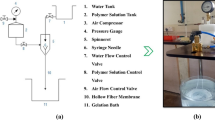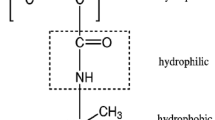Abstract
The difference in the structural properties of highly charged polyacrylic acid (PAA) and polymethacrylic acid (PMA) is investigated by atomistic molecular dynamics (MD) simulations in the presence of divalent salt magnesium chloride. A united-atom model approach was used to represent the backbone methylene groups in both the polymers. The salt concentration (Cs) dependence of conformational radius of gyration (Rg) and chain persistence length (Lp) is discussed in detail for PAA and PMA. The Rg showed a decrease with Cs for both PAA and PMA. However, the PMA Rg is greater than PAA at the salt concentration range of 0.1 < Cs < 0.9 M. The chain stiffness calculated by Lp demonstrated a decrease with Cs for both PAA and PMA. However, the Lp of PMA at Cs ≥ 0.7 M is greater than PAA, rendering it stiffer than its counterpart at higher salt concentration. The total number of intermolecular hydrogen bonds between PAA and water is greater compared to PMA–water at all Cs values. This behavior may be attributed to methyl side groups in PMA, rendering it more hydrophobic. The coordination number value for PAA–water is greater than the PMA–water pair across the entire Cs range. However, the number of h-bonds does not change with variations in Cs for both PAA and PMA. The degree of counterion binding to the polyelectrolyte quantified by coordination number shows a decrease with Cs due to an increase in salt concentration and replacement of Na+ counterions by divalent Mg2+ salt ions for PAA and PMA. The spatial distribution of salt ions shows an increase in PAA-Mg2+ and PMA-Mg2+ coordination number with Cs. However, the coordination number for PAA-Mg2+ is greater than its counterpart at all Cs values indicating a significant electrostatic charge screening in the case of the PAA compared to PMA. Overall, the understanding pertaining to the differences in the microstructure, hydrogen bonding, intermolecular structure, and salt-ion distribution around PAA and PMA in the dilute aqueous divalent salt solution is significantly advanced in the present work.
Graphical abstract











Similar content being viewed by others
References
Carrillo JMY, Dobrynin AV (2011) Polyelectrolytes in salt solutions: Molecular dynamics simulations. Macromolecules 44:5798–5816. https://doi.org/10.1021/ma2007943
Dobrynin AV, Rubinstein M (2005) Theory of polyelectrolytes in solutions and at surfaces. Prog Polym Sci 30:1049–1118. https://doi.org/10.1016/j.progpolymsci.2005.07.006
Dobrynin AV (2008) Theory and simulations of charged polymers: From solution properties to polymeric nanomaterials. Curr Opin Colloid Interface Sci 13:376–388. https://doi.org/10.1016/j.cocis.2008.03.006
Colby RH (2010) Structure and linear viscoelasticity of flexible polymer solutions: Comparison of polyelectrolyte and neutral polymer solutions. Rheol Acta 49:425–442. https://doi.org/10.1007/s00397-009-0413-5
De Gennes PG, Pincus P, Velasco RM, Brochard F (1976) Remarks on polyelectrolyte conformation. J Phys 37:1461–1473. https://doi.org/10.1051/jphys:0197600370120146100
Estahbanati MRK, Feilizadeh M, Attar F, Iliuta MC (2021) Current developments and future trends in photocatalytic glycerol valorization: photocatalyst development. Ind Eng Chem Res. https://doi.org/10.1021/acs.iecr.0c04765
Sappidi P, Muralidharan SS, Natarajan U (2014) Conformations and hydration structure of hydrophobic polyelectrolyte atactic poly(ethacrylic acid) in dilute aqueous solution as a function of neutralisation. Mol Simul 40:295–305. https://doi.org/10.1080/08927022.2013.803551
Vao-soongnern V, Merat K, Horpibulsuk S (2016) Interaction of the calcium ion with poly(acrylic acid) as investigated by a combination of molecular dynamics simulation and X-ray absorption spectroscopy. J Polym Res 23:1–7. https://doi.org/10.1007/s10965-015-0895-z
Frster S, Schmidtt M, Polymerforschung M, Mainz D (1989) Static and dynamic light scattering by aqueous polyelectrolyte solutions: effect of molecular weight charge, density and added salt. Polymer (Guildf) 31:781–792
Hriberšek P, Kogej K (2019) Effect of multivalent cations on intermolecular association of isotactic and atactic poly(methacrylic acid) chains in aqueous solutions. Polymers (Basel) 11:1–18. https://doi.org/10.3390/polym11040605
Beer M, Schmidt M, Muthukumar M (1997) The electrostatic expansion of linear poly electrolytes: effects of gegenions, co-ions, and hydrophobicity. Macromolecules 30:8375–8385
Sitar S, Aseyev V, Žagar E, Kogej K (2019) Chain dynamics and intermolecular association in dilute aqueous solutions of isotactic and atactic Poly (Methacrylic acid): Effect of NaCl concentration. Polymer 174:1–10
Huber K (1993) Calcium-induced shrinking of polyacrylate chains in aqueous solution. J Phys Chem 97:9825–9830
Schweins R, Goerigk G, Huber K (2006) Shrinking of anionic polyacrylate coils induced by Ca2+, Sr2+ and Ba2+: a combined light scattering and ASAXS study. Europ Phys J E 21:99–110
Roiter Y, Trotsenko O, Tokarev V (2010) Single molecule experiments visualizing adsorbed polyelectrolyte molecules in the full range of mono- and divalent counter ion concentration. J Am Chem Soc 132:13660–13662
Koene RS, Mandel M (1983) Scaling relations for aqueous polyelectrolyte-salt solutions. 1. Quasi-elastic light scattering as a function of polyelectrolyte concentration and molar mass. Macromolecules 16(2):220–7
Koene RS, Nicolai T, Mandel M (1983) Scaling relations for aqueous polyelectrolyte-salt solutions. 2. Quasi-elastic light scattering as a function of polyelectrolyte concentration and salt concentration. Macromolecules 16(2):227–31
Sarraguça JMG (2003) Structure of polyelectrolytes in 3: 1 salt solutions Structure of polyelectrolytes in 3: 1 salt solutions. J Chem Phys 119:12621–12628
Wei YF, Hsiao PY (2010) Effect of chain stiffness on ion distributions around a polyelectrolyte in multivalent salt solutions. J Chem Phys 132:024905-1–024905-12
Wei YF, Hsiao PY (2007) Role of chain stiffness on the conformation of single polyelectrolytes in salt solutions. J Chem Phys 127:064901-1–064901-14
Liu S, Ghosh K, Muthukumar M (2003) Polyelectrolyte solutions with added salt: a simulation study. J Chem Phys 119:1813–1823
Hsiao PY, Luijten E (2006) Salt-induced collapse and reexpansion of highly charged flexible polyelectrolytes. Phys Rev Lett 97:148301-1–148301-4
Hsiao PY (2006) Chain morphology, swelling exponent, persistence length, like-charge attraction, and charge distribution around a chain in polyelectrolyte solutions: effects of salt concentration and ion size studied by molecular dynamics simulations. Macromolecules 39(20):7125–7137
Kłos J, Pakula T (2005) Computer simulations of a polyelectrolyte chain with a mixture of multivalent salts. J Phys: Condens Matter 17(37):5635–5645
Gupta AK (2021) Combined salt concentration and degree-of-ionization effect on the structure of poly (methacrylic acid) in aqueous solutions as revealed by molecular dynamics simulations. Ind Eng Chem Res 60(13):4806–4819
Accelrys Software Inc: Materials Studio Modeling Environment. Release 5.0. San Diego: USA; 2007.
Gupta AK (2021) Salt ions induced transport properties of poly (methacrylic acid) PMA in aqueous solutions studied by molecular dynamics simulations. Mater Today: Proc 1(44):2380–2385
Gupta AK (2021) Molecular dynamics simulations studies of transport properties of sodium-(polymethacrylate)(Na+-PMA) in aqueous solutions–Effect of salt concentration. Mater Today: Proc 1(43):3085–3090
Gupta AK, Natarajan U (2016) Tacticity effects on conformational structure and hydration of poly- (methacrylic acid) in aqueous solutions-a molecular dynamics simulation study. Mol Simul 42:725–736
Gupta AK, Natarajan U (2017) Anionic polyelectrolyte poly (acrylic acid)(PAA) chain shrinkage in water–ethanol solution in presence of Li+ and Cs+ metal ions studied by molecular dynamics simulations. Mol Simul 43:625–637
Hess B, Bekker H, Berendsen HJ, Fraaije JG (1997) LINCS: a linear constraint solver for molecular simulations. J Comput Chem 18:1463–1472
Chremos A, Douglas JF (2016) Counter-ion distribution around flexible polyelectrolytes having different molecular architecture. Soft Matter 12:2932–2941
Schweins R, Huber K (2001) Collapse of sodium polyacrylate chains in calcium salt solutions. Eur Phys J E 5(1):117–126
Prabhu VM, Muthukumar M, Wignall GD, Melnichenko YB (2003) Polyelectrolyte chain dimensions and concentration fluctuations near phase boundaries. J Chem Phys 119(7):4085–4098
Prabhu VM, Muthukumar M, Wignall GD, Melnichenko YB (2001) Dimensions of polyelectrolyte chains and concentration fluctuations in semidilute solutions of sodium–poly (styrene sulfonate) as measured by small-angle neutron scattering. Polymer 42(21):8935–8946
Le Bret M (1982) Electrostatic contribution to the persistence length of a polyelectrolyte. J Chem Phys 76(12):6243–6255
Fixman M (1982) The flexibility of polyelectrolyte molecules. J Chem Phys 76(12):6346–6353
Odijk T (1977) Polyelectrolytes near the rod limit. J Polym Sci: Polymer Phys Ed 15(3):477–483
Förster S, Schmidt M, Antonietti M (1992) Experimental and theoretical investigation of the electrostatic persistence length of flexible polyelectrolytes at various ionic strengths. J Phys Chem 96(10):4008–4014
Oosawa, F. Polyelectrolytes; Marcel Dekker, 1971
Washizu H, Kikuchi K (2002) Electrical polarizability of polyelectrolytes in salt-free aqueous solution. J Phys Chem B 106:11329–11342
Callahan KM, Casillas-Ituarte NN, Roeselová M, Allen HC, Tobias DJ (2010) Solvation of magnesium dication: molecular dynamics simulation and vibrational spectroscopic study of magnesium chloride in aqueous solutions. J Phys Chem A 114(15):5141–5148
Pálinkás G, Radnai T (1982) Hydration shell structures in an MgCl2 solution from X-ray and MD studies. Zeitschrift für Naturforschung A 37(9):1049–1060
Albright JN (1972) X-Ray diffraction studies of aqueous alkaline-earth chloride solutions. J Chem Phys 56(8):3783–3786
Skipper NT, Neilson GW, Cummings SC (1989) An X-ray diffraction study of Ni (aq) 2+ and Mg (aq) 2+ by difference methods. J Phys: Condens Matter 1(22):3489–3506
Acknowledgements
The authors are grateful to the School of Technology, Pandit Deendayal Energy University, Gandhinagar, for providing the necessary computing resources to perform the simulations presented in this work.
Author information
Authors and Affiliations
Corresponding author
Ethics declarations
Conflict of interest
There are no conflicts to declare.
Additional information
Handling Editor: M. Grant Norton.
Publisher's Note
Springer Nature remains neutral with regard to jurisdictional claims in published maps and institutional affiliations.
Supplementary Information
Below is the link to the electronic supplementary material.
Rights and permissions
About this article
Cite this article
Gupta, A.K., Gohil, S. Insights into structural difference between sodium polyacrylate PAA and sodium polymethacrylate PMA in salt solutions investigated by molecular simulations. J Mater Sci 57, 10569–10584 (2022). https://doi.org/10.1007/s10853-021-06836-8
Received:
Accepted:
Published:
Issue Date:
DOI: https://doi.org/10.1007/s10853-021-06836-8




